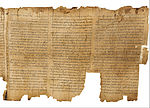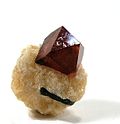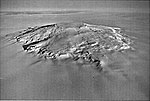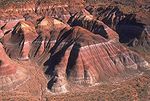Radiometric dating, radioactive dating or radioisotope dating is a technique which is used to date materials such as rocks or carbon, in which trace radioactive... 44 KB (5,517 words) - 02:21, 14 March 2024 |
Uranium–lead dating, abbreviated U–Pb dating, is one of the oldest and most refined of the radiometric dating schemes. It can be used to date rocks that... 9 KB (1,273 words) - 17:38, 25 April 2024 |
 | Age of Earth (section Radiometric dating) Earth formed. This dating is based on evidence from radiometric age-dating of meteorite material and is consistent with the radiometric ages of the oldest-known... 45 KB (5,444 words) - 18:45, 23 February 2024 |
 | Radiocarbon dating (also referred to as carbon dating or carbon-14 dating) is a method for determining the age of an object containing organic material... 104 KB (13,848 words) - 09:55, 12 May 2024 |
Uranium–thorium dating, also called thorium-230 dating, uranium-series disequilibrium dating or uranium-series dating, is a radiometric dating technique established... 10 KB (1,180 words) - 20:32, 12 May 2024 |
Potassium–argon dating, abbreviated K–Ar dating, is a radiometric dating method used in geochronology and archaeology. It is based on measurement of the... 15 KB (1,884 words) - 13:37, 5 November 2023 |
period of 40 million years this provides an alternate verification to radiometric dating in cases where sufficient record exists to provide a reliable trace... 3 KB (447 words) - 00:38, 5 October 2023 |
 | Zircon (section Radiometric dating) Australia. Zircon has played an important role during the evolution of radiometric dating. Zircons contain trace amounts of uranium and thorium (from 10 ppm... 29 KB (3,034 words) - 07:39, 12 April 2024 |
 | Thorium (section Radiometric dating) Two radiometric dating methods involve thorium isotopes: uranium–thorium dating, based on the decay of 234U to 230Th, and ionium–thorium dating, which... 136 KB (15,857 words) - 20:13, 12 May 2024 |
 | Geochronology (redirect from Geologic dating) determined by dating of seafloor magnetic anomalies, radiometrically dating volcanic rocks within magnetostratigraphic sections, and astronomically dating magnetostratigraphic... 16 KB (1,829 words) - 18:33, 19 February 2024 |
absolute dating methods to rock sediment in order to discover their period of origin. Some examples of both radiometric and non-radiometric absolute dating methods... 17 KB (2,113 words) - 00:29, 8 November 2023 |
 | the Quaternary period, from 2.5 million years ago to the present. Radiometric dating has yielded ages of up to 300,000 years for its rocks, and it reached... 53 KB (5,485 words) - 17:20, 11 May 2024 |
The rubidium-strontium dating method (Rb-Sr) is a radiometric dating technique, used by scientists to determine the age of rocks and minerals from their... 14 KB (1,875 words) - 19:20, 12 May 2024 |
 | Chinle Formation (section Radiometric dating) with magnetostratigraphy and radiometric dating, and are considered more accurate. Since 2011, widespread radiometric dating has helped to refine precise... 48 KB (4,789 words) - 10:32, 6 May 2024 |
well-known absolute dating techniques is carbon-14 (or radiocarbon) dating, which is used to date organic remains. This is a radiometric technique since it... 14 KB (1,774 words) - 03:07, 8 November 2023 |
Meteoritics (section Radiometric dating) orientations, and chemical compositions; analysis of isotope ratios; and radiometric dating. These techniques are used to determine the age, formation process... 11 KB (1,267 words) - 19:20, 15 February 2023 |
 | Uranium-238 (category Radionuclides used in radiometric dating) dating techniques and is one of the most common radioactive isotopes used in radiometric dating. The most common dating method is uranium-lead dating... 22 KB (2,809 words) - 12:00, 1 April 2024 |
displaying the current date Chronological dating, attributing to an object or event a date in the past Radiometric dating, dating materials such as rocks... 2 KB (306 words) - 16:54, 17 March 2024 |
 | Old Style and New Style dates (redirect from Old Style date) calendar changes, writers used dual dating to identify a given day by giving its date according to both styles of dating. For countries such as Russia where... 31 KB (3,785 words) - 11:43, 20 April 2024 |
such as radiometric dating, the technique can be used to construct and calibrate the geomagnetic polarity time scale. This is one of the dating methodologies... 6 KB (733 words) - 19:29, 16 October 2022 |
Argon–argon (or 40Ar/39Ar) dating is a radiometric dating method invented to supersede potassium–argon (K/Ar) dating in accuracy. The older method required... 9 KB (1,101 words) - 18:17, 31 March 2024 |
 | Isochron dating is a common technique of radiometric dating and is applied to date certain events, such as crystallization, metamorphism, shock events... 11 KB (1,617 words) - 00:13, 14 October 2023 |
 | Creation science (section Radiometric dating) rates affecting the reliability of radiometric dating, Roger C. Wiens, a physicist specializing in isotope dating states: There are only three quite technical... 104 KB (11,154 words) - 01:52, 12 May 2024 |
Luminescence dating refers to a group of chronological dating methods of determining how long ago mineral grains were last exposed to sunlight or sufficient... 18 KB (2,545 words) - 09:42, 1 February 2024 |
 | Uranium-235 (category Radionuclides used in radiometric dating) Uranium-235 (235U or U-235) is an isotope of uranium making up about 0.72% of natural uranium. Unlike the predominant isotope uranium-238, it is fissile... 12 KB (1,194 words) - 21:00, 27 March 2024 |
Geochronometry (category Geochronological dating methods) the dating problem arrived only with the discovery that some natural elements undergo a continuous decay. This led to the first radiometric datings by... 6 KB (808 words) - 15:19, 22 April 2022 |
Samarium–neodymium dating is a radiometric dating method useful for determining the ages of rocks and meteorites, based on the alpha decay of the long-lived... 14 KB (1,869 words) - 05:07, 4 March 2024 |
Epoch (redirect from Epoch date) radiocarbon dating, the reference date is January 1, 1950 (though the specific date January 1 is quite unnecessary, as radiocarbon dating has limited... 10 KB (1,214 words) - 10:58, 7 January 2024 |


